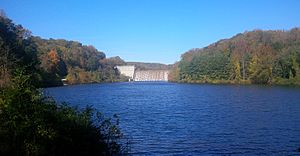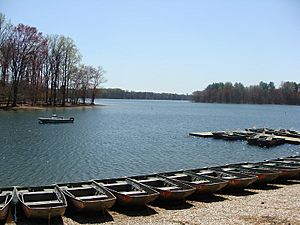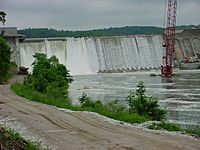Loch Raven Reservoir facts for kids
Quick facts for kids Loch Raven Reservoir |
|
|---|---|

Aerial view facing northwest
|
|
| Location | Baltimore County, Maryland |
| Coordinates | 39°27′N 76°34′W / 39.450°N 76.567°W |
| Type | reservoir |
| Primary inflows | Big Gunpowder Falls river |
| Primary outflows | Big Gunpowder Falls river |
| Basin countries | United States |
| Max. length | 10.7 miles (17.2 km) |
| Surface area | 3.75 sq mi (9.7 km2) |
| Water volume | 23 billion US gallons (0.087 km3) |
The Loch Raven Reservoir is a large reservoir in Maryland. It provides clean drinking water for the city of Baltimore and most of Baltimore County. The reservoir gets its water from the Big Gunpowder Falls river. It can hold a huge amount of water, about 23 billion US gallons (87,000,000 m3).
The first dam was built in 1881 to send water to other lakes. Later, in 1914, a new, bigger dam was built. This created the large lake we see today. It even covered up a cotton mill town called Warren! In 1923, the dam was made even taller, rising from 51 to 117 feet (16 to 36 m). Many people saw this as a big step for Baltimore after the Great Fire of 1904.
Besides providing drinking water, Loch Raven Reservoir is also a fun place for people to visit. It's like a big park where you can enjoy nature. The City of Baltimore has a website about the reservoir at lochraven.org.
| Top - 0-9 A B C D E F G H I J K L M N O P Q R S T U V W X Y Z |
Building the Reservoir: A Look Back
The idea for the reservoir started in 1908. The city council approved it and set aside $5,000,000 USD to begin the project. The main dam was built between 1912 and 1914. When it was finished, the top of the dam was 188 feet (57 m) above sea level. It was 51 feet (16 m) tall from the valley floor.
Building the dam used a lot of concrete, about 50,800 cubic yards (38,800 m3). They also built seven miles of new roads and three new bridges. These bridges were for Loch Raven Drive, Paper Mill Road, and Dulaney Valley Road. Today, only the bridge on Warren Road is still the original one. A large steel pipe, 10-foot (3.0 m) wide and 1,623 feet (495 m) long, was also built. This pipe connected the upper and lower parts of the dam. It then linked to a main tunnel that stretched seven miles (11 km) all the way to Lake Montebello in Baltimore.
Near the original 1881 Loch Raven dam, there is a special stone. It has information carved into its four sides and top. This stone tells us about the reservoir's size, how the dam was built, and details about the long tunnel. It also lists the engineers who worked on the project. The key stone was placed on October 6, 1881.
Bridges Over the Water
Loch Raven Reservoir has several interesting bridges. Four of them were built so roads could cross the water.
- The first bridge on Loch Raven Drive was built in 1906. The road had a very sharp turn, called a hairpin turn, which caused many accidents. In 1988, this old bridge was replaced with a safer one.
- The second bridge, known as the Matthews Bridge, was built in 1914 on Maryland 146. This bridge was taken down in 1978 and replaced with a newer design.
- The third bridge is the Old Paper Mill Bridge. It was built in 1922 on Maryland 145. Before this, a covered bridge stood in its place. A new bridge was built next to it in 2001 for cars to use. The 1922 bridge is now kept for people to enjoy for fun.
- The last bridge is on Warren Road. It was built in 1923 and is still used by cars today.
On October 26, 1958, something unusual happened near one of the bridges. Two men in a car said they saw a "large, flat egg-shaped object" floating above the bridge. After the object left, they felt a burning feeling on their skin and went to a hospital. This event was looked into by Project Blue Book, which studied UFO sightings.
Fun Activities at the Reservoir
Loch Raven Reservoir is a great place for outdoor activities. You can find the Loch Raven Skeet & Trap shooting range here. There are also many trails for walking or running, and nice picnic areas.
If you like being on the water, you can go fishing. You can also use your own boat or rent one right at the dock. The reservoir also has trails for running and a frisbee golf course. On weekends, a part of Loch Raven Drive (between Morgan Mill Road and Providence Road) is closed to cars. This allows people to walk, run, or bike safely.
However, because the reservoir provides drinking water, swimming in it is not allowed. Officers from the Watershed Police, who work for the Baltimore City Department of Public Works, patrol the reservoir and its surrounding areas to keep everyone safe and protect the water.
 Geographic data related to Loch Raven Reservoir at OpenStreetMap
Geographic data related to Loch Raven Reservoir at OpenStreetMap- Historic American Engineering Record (HAER) No. MD-68, "Matthews Bridge", 11 photos, 2 data pages, 1 photo caption page







